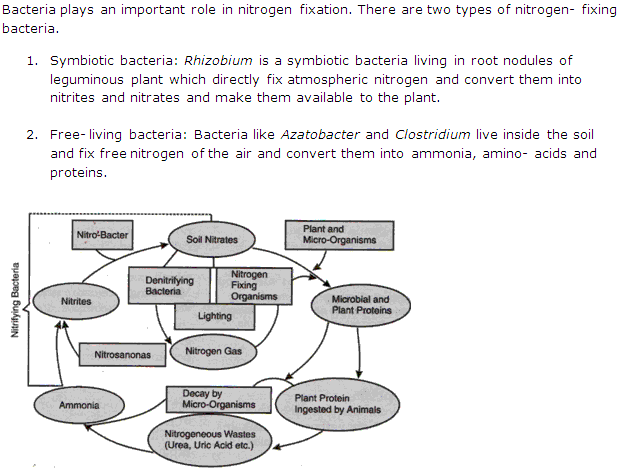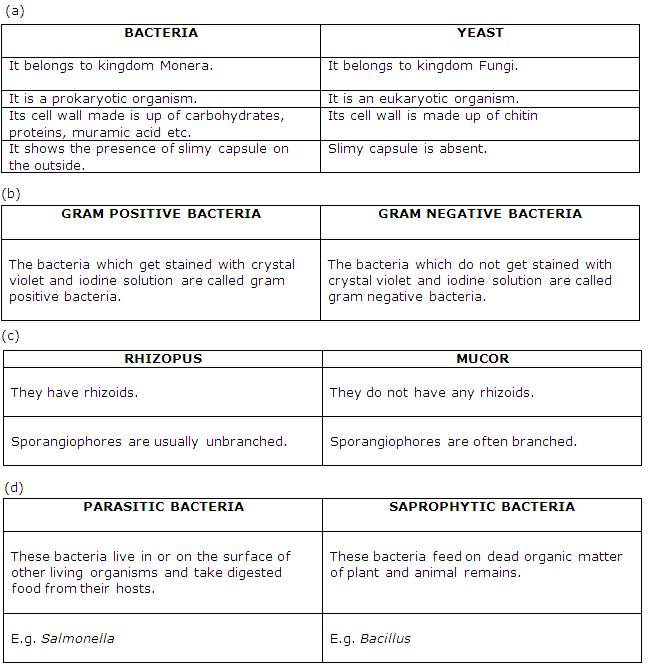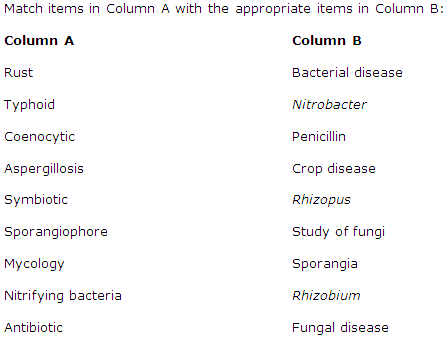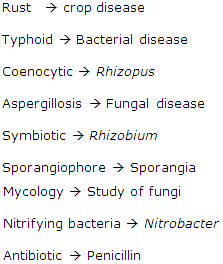Chapter 14 - Bacteria and Fungi: Their Importance Exercise 127
Question 1
Define the following:
(a) Bacteria
(b) Gram negative and Gram positive bacteria.
(a) Bacteria
(b) Gram negative and Gram positive bacteria.
Solution 1
(a) Bacteria are a large group of unicellular, prokaryotic microorganisms.
(b) The bacteria which do not get stained with crystal violet and iodine solution are called gram negative bacteria while those bacteria which get stained with crystal violet and iodine solution are called gram positive bacteria.
(b) The bacteria which do not get stained with crystal violet and iodine solution are called gram negative bacteria while those bacteria which get stained with crystal violet and iodine solution are called gram positive bacteria.
Question 2
Explain briefly:
(a) Bacteria is a plant.
(b) Spore formation is a survival technique not a mode of reproduction in bacteria.
(c) Bacteria are our friends and foes both.
(d) Yeast is used in bakeries and breweries.
(a) Bacteria is a plant.
(b) Spore formation is a survival technique not a mode of reproduction in bacteria.
(c) Bacteria are our friends and foes both.
(d) Yeast is used in bakeries and breweries.
Solution 2
(a) Bacteria shows the presence of cell wall, hence they are included under plants.
(b) Spore formation helps bacteria to survive during adverse environmental conditions. Hence it is a survival technique.
(c) Bacteria as friends :
Bacteria are useful to us in many ways like producing antibiotics, forming curd and cheese, tanning leather, producing various industrial products, nitrogen fixation, digesting cellulose etc.
Bacteria as foes:
They are harmful in many ways like causing diseases, bio-weapons , food spoilage etc.
(d) Yeast is used in breweries since the fermentation activity of yeast produces different types of beverages like wine, beer, alcohol toddy etc. In bakeries, when yeast is added to the flour its fermentation results in the production of carbon dioxide which produces soft bread and other bakery products.
(b) Spore formation helps bacteria to survive during adverse environmental conditions. Hence it is a survival technique.
(c) Bacteria as friends :
Bacteria are useful to us in many ways like producing antibiotics, forming curd and cheese, tanning leather, producing various industrial products, nitrogen fixation, digesting cellulose etc.
Bacteria as foes:
They are harmful in many ways like causing diseases, bio-weapons , food spoilage etc.
(d) Yeast is used in breweries since the fermentation activity of yeast produces different types of beverages like wine, beer, alcohol toddy etc. In bakeries, when yeast is added to the flour its fermentation results in the production of carbon dioxide which produces soft bread and other bakery products.
Question 3
Draw a labelled diagram of a bacterial cell.
Solution 3

Question 4
Write short notes on:
(a) Shape of bacteria
(b) Flagellation in bacteria
(c) Economic importance of yeast
(d) Structure of Rhizopus
(a) Shape of bacteria
(b) Flagellation in bacteria
(c) Economic importance of yeast
(d) Structure of Rhizopus
Solution 4

Question 5
Explain, briefly the role of bacteria in nitrogen fixation.
Solution 5

Chapter 14 - Bacteria and Fungi: Their Importance Exercise 128
Question 1
How are fungi important as food?
Solution 1
Fungi are cooked like vegetables or used in pulao or prepared as soups. Some common edible fungi are Agaricus, Ramaria, Clavaria, Morchella.
Also yeast is used in preparing idli and dosa from a mixture of powdered rice and dal.
Also yeast is used in preparing idli and dosa from a mixture of powdered rice and dal.
Question 2
Are fungi useful in medical sciences? How?
Solution 2
Yes. Many types of antibiotics are obtained from fungi which are used in medical sciences. Today about 25 types of antibiotics are commercially produced from moulds.
For example: Penicillin is obtained from the fungus Penicillium notatum.
Griseofulvin is extracted from the fungus Penicillium griseofulvum.
For example: Penicillin is obtained from the fungus Penicillium notatum.
Griseofulvin is extracted from the fungus Penicillium griseofulvum.
Question 3
Name two plant diseases caused by fungi. Also, mention the causal agents.
Solution 3

Question 4
Every question has four options. Choose the correct answer:
(i) Which scientist first discovered the bacteria?
(a) Pasteur
(b) Leeuwenhoek
(c) Koch
(d) De Vries
(ii) Bacteriology is the study of
(a) bacteria
(b) virus
(c) fungi
(d) mycoplasms
(iii) Which bacteria is rod-shaped?
(a) Coccus
(b) Bacillus
(c) Spirillum
(d) None of these
(iv) Which disease is caused by bacteria?
(a) Tuberculosis
(b) Aspergillosis
(c) Measles
(d) None of these
(v) Which fixes the atmospheric nitrogen?
(a) Nitrobacter
(b) Nitrosomonas
(c) Xanthomonas
(d) Rhizobium
(vi) Which bacteria is useful in fermentation of milk?
(a) Hay bacillus
(b) Lactobacillus
(c) Aceto bacillus
(d) Rhizobium
(vii) Tasteful food for man is
(a) Rhizopus
(b) Penicillium
(c) Amantia
(d) Agaricus
(viii) Yeast is used in the production of
(a) ethyl alcohol
(b) acetic acid
(c) cheese
(d) curd
(i) Which scientist first discovered the bacteria?
(a) Pasteur
(b) Leeuwenhoek
(c) Koch
(d) De Vries
(ii) Bacteriology is the study of
(a) bacteria
(b) virus
(c) fungi
(d) mycoplasms
(iii) Which bacteria is rod-shaped?
(a) Coccus
(b) Bacillus
(c) Spirillum
(d) None of these
(iv) Which disease is caused by bacteria?
(a) Tuberculosis
(b) Aspergillosis
(c) Measles
(d) None of these
(v) Which fixes the atmospheric nitrogen?
(a) Nitrobacter
(b) Nitrosomonas
(c) Xanthomonas
(d) Rhizobium
(vi) Which bacteria is useful in fermentation of milk?
(a) Hay bacillus
(b) Lactobacillus
(c) Aceto bacillus
(d) Rhizobium
(vii) Tasteful food for man is
(a) Rhizopus
(b) Penicillium
(c) Amantia
(d) Agaricus
(viii) Yeast is used in the production of
(a) ethyl alcohol
(b) acetic acid
(c) cheese
(d) curd
Solution 4
(i) (b) Leeuwenhoek
(ii) (a) bacteria
(iii) (b) Bacillus
(iv) (a) Tuberculosis
(v) (d) Rhizobium
(vi) (b) Lactobacillus
(vii) (d) Agaricus
(viii) (a) ethyl alcohol
(ii) (a) bacteria
(iii) (b) Bacillus
(iv) (a) Tuberculosis
(v) (d) Rhizobium
(vi) (b) Lactobacillus
(vii) (d) Agaricus
(viii) (a) ethyl alcohol
Question 5
Differentiate between:
(a) Bacteria and Yeast
(b) Gram positive and Gram negative bacteria
(c) Rhizopus and Mucor
(d) Parasitic and Saprophytic bacteria
(a) Bacteria and Yeast
(b) Gram positive and Gram negative bacteria
(c) Rhizopus and Mucor
(d) Parasitic and Saprophytic bacteria
Solution 5

Question 6
Give the name of the
(a) fungus that gives penicillin.
(b) mould that causes Aspergillosis in human beings.
(c) mould which is known as Red-ring mould.
(d) mould that causes lung mycosis.
(a) fungus that gives penicillin.
(b) mould that causes Aspergillosis in human beings.
(c) mould which is known as Red-ring mould.
(d) mould that causes lung mycosis.
Solution 6
(a) Penicillium notatum
(b) Aspergillus fumigatus
(c) Candida albicans
(d) Aspergillus
(b) Aspergillus fumigatus
(c) Candida albicans
(d) Aspergillus
Question 7
Fill in the blanks:
(a) The cell-wall of fungi is made up of ______.
(b) The fungi are ______ in their mode of nutrition.
(c) Bacteria which cannot live without oxygen is called ______.
(d) Fungi which is edible is ______.
(a) The cell-wall of fungi is made up of ______.
(b) The fungi are ______ in their mode of nutrition.
(c) Bacteria which cannot live without oxygen is called ______.
(d) Fungi which is edible is ______.
Solution 7
(a) chitin
(b) saprophytic
(c) obligate aerobes
(d) Agaricus campestris
(b) saprophytic
(c) obligate aerobes
(d) Agaricus campestris
Question 8

Solution 8


0 comments:
Post a Comment